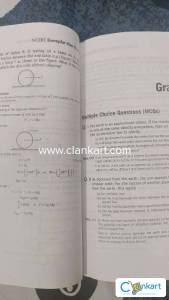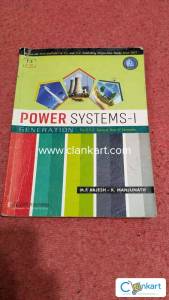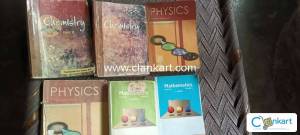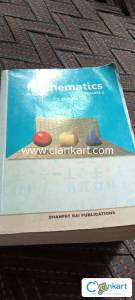Buy used Engineering Books online in India
Buy Second Hand Books, Used Books Online In India
Arihant Physics Exemplar class 11
NCERT Exemplar Problems - Solutions Physics, published by Arihant Publications, is a comprehensive book for Class XI students. It consists of an exhaustive collection of problems and solutions prescribed for engineering and medical competitive examinations. Continuing the tradition of its reliable set of books for competitive exams from Class IX to class XII, Arihant has covered a vast range of topics in Physics that are relevant for Class XI students. This book is divided into 14 chapters, strictly following the board syllabus and exam pattern, encompassing a variety of topics in Classical Mechanics - from laws of motion to theory of waves. It is highly recommended for anyone who wants to build a strong foundation in physics before venturing out in the areas of science and technology in higher studies.
Arihant Physics Exemplar for Class12
NCERT Exemplar Problems - Solutions Physics (Class 12) is a comprehensive book for students of standard XII studying in schools affiliated to the Central Board of Secondary Education. The book comprises chapters on electric charges and fields, electrostatic potential and capacitance, current electricity, magnetism and matter, alternating current, electromagnetic waves, wave optics and dual nature of radiation and matter. In addition, the book consists of several multiple choice questions for thorough revision and final practice. This book is essential for students preparing for various engineering entrance examinations.
Networks,Lines And Fields
This well-established and widely adopted book, now in its Sixth Edition, provides a thorough analysis of the subject in an easy-to-read style. It analyzes, systematically and logically, the basic concepts and their applications to enable the students to comprehend the subject with ease. The book begins with a clear exposition of the background topics in chemical equilibrium, kinetics, atomic structure and chemical bonding. Then follows a detailed discussion on the structure of solids, crystal imperfections, phase diagrams, solid-state diffusion and phase transformations. This provides a deep insight into the structural control necessary for optimizing the various properties of materials. The mechanical properties covered include elastic, anelastic and viscoelastic behaviour, plastic deformation, creep and fracture phenomena. The next four chapters are devoted to a detailed description of electrical conduction, superconductivity, semiconductors, and magnetic and dielectric properties. The final chapter on ‘Nanomaterials’ is an important addition to the sixth edition. It describes the state-of-art developments in this new field. This eminently readable and student-friendly text not only provides a masterly analysis of all the relevant topics, but also makes them comprehensible to the students through the skillful use of well-drawn diagrams, illustrative tables, worked-out examples, and in many other ways. The book is primarily intended for undergraduate students of all branches of engineering (B.E./B.Tech.) and postgraduate students of Physics, Chemistry and Materials Science. KEY FEATURES • All relevant units and constants listed at the beginning of each chapter • A note on SI units and a full table of conversion factors at the beginning • A new chapter on ‘Nanomaterials’ describing the state-of-art information • Examples with solutions and problems with answers • About 350 multiple choice questions with answers
PRADEEP NEW COURSE CLASS 12 VOL 2
Handbook of Mathematics Formulae Book For IIT-JEE, KVPY, NTSE, Olympiad and all other Engineering Entrance Exams Many excellent books are available in the market & each of them represents the subject matter in a highly explanatory manner. However, the students preparing for the competitive examinations also need a comprehensive book on formulae for quick reference and revision. This hand-book of Mathematics Formulae, therefore, will address this need of students. This little book is an attempt to present the basic formulae in a quick reference format. A student may find this book as a handy aid for gaining rapid insight into the new formulae. Whether a student is doing exercises, homework, or preparing for the tests, this book will give them a quick easy reference to the formulae. The book contains most of the formulae from the syllabus of competitive examination, covering all the topics. Additionally, a systematic index incorporated at the beginning of the hand-book allows a user to locate the required formulae swiftly and simply. We have tried our best to keep errors out of this book. Though we shall be grateful to the readers if they point out any errors and/or make constructive suggestions. We wish to utilize the opportunity to place on record our special thanks to all members of the Content Development team for their efforts to create this wonderful book. Career Point Ltd, Kota (Rajasthan).
RD SHARMA VOLUME 2 CLASS 12
This text book is based on the the latest syllabus prescribed by the CBSE. The whole syllabus has been divided into two volumes. Volume - I consists of Chapter 1-19 and Volume - II consists of Chapter 20-32. In this revised edition new chapters on Relations, Functions, Binary Operations and Inverse Trigonometric Functions have been included.All other chapters have been thoroughly revised and up-dated. In each chapter all concepts and definitions have been discussed in detail with suitable illustrative examples. At the end of each chapters an exercise consisting of multiple choice questions (MCQs) have been given. For the sake of quick revision of concepts and formulae, a brief summary has been given at the end of each chapter.Key FeaturesDetailed theory with illustrationsAlgorithmic approachLarge number of graded solved examplesLarge number of unsolved exercises.About the AuthorDr. R.D. Sharma is currently working as Head of Deptl. (Science and Humanities) under the Directorate of Technical Education, Delhi. A Ph.D in Mathematics, He is a double gold medalist, ranking first in the order of merit in both B.Sc (Hons.) and M.Sc. Examinations from the University of Rajasthan, Jaipur.He has undergone rigorous training from IIT, Kharagpur in computer-oriented mathematical methods and has a long experience of teaching post graduate, graduate and engineering students.Table of Contents20. Definite Integrals21. Areas of Bounded Regions22. Differential Equations23. Algebra of Vectors24. Scalar Triple Product25. Vector or Cross Product26. Scalar Triple Product27. Direction Cosines and Direction Ratios28. Straight Line In Space29. The Plane30. Linear Programming31. Probability32. Mean and Variance of a Random Variable33. Binomial DistributionAppendix
ORGANIC CHEMISTRY BY SOLOMONSFRYHLESNYDER (MS CHOUHAN) 2024
Hydraulic Machines (Fluid Machinery) has been designed as a textbook for engineering students specializing in mechanical, civil, electrical, hydraulics, chemical and power engineering. The highlights of the book are simple language supported by analytical and graphical illustrations. A large number of theory questions and numerical problems with solution hints have been annexed at the end of every chapter. A large number of objective questions have been included to help the students opting for competitive examinations. Five case studies based on research have been included which can be advantageously used by practising engineers pursuing research design and consultancy careers. Complete design of hydraulic machines has been demonstrated with the help of suitable examples. The book has been divided into six parts containing 13 chapters.
Arihant Differential Calculus
1. Skill in Mathematics’ series is prepared for JEE Main and Advanced papers 2. It is a highly recommended textbook to develop a strong grounding in Differential Calculus 3. The book covers the entire syllabus into 8 chapters 4. Each chapter includes a wide range of questions that are asked in the examinations Good foundational grip is required in the Differential Calculus, while you are preparing for JEE Mains & Advanced or any other engineering. Bringing up the series “Skills in Mathematics for JEE Main & Advanced for Differential Calculus” that is carefully revised with the sessionwise theory and exercise; to help candidates to learn & tackle the mathematical problems. The book has 8 Chapters covering the whole syllabus for the JEE Mains and Advanced as prescribed. Each chapter is divided into sessions giving complete clarity to concepts. Apart from sessionwise theory, JEE Type examples and Chapter Exercise contain huge amount of questions that are provided in every chapter under Practice Part. Prepared under great expertise, it is a highly recommended textbook to develop a strong grounding in Algebra to perform best in JEE and various engineering entrances. TOC: Essential Mathematical Tools, Differentiation, Functions, Graphical Transformations, Limits, Continuity and Differentiability, dy/dx As a Rate Measurer & Tangents, Normals, Monotonicity, Maxima and Minima.
GRB OP Tandon Inorganic Chemistry for Class 12 JEE Mains and Advanced
An advanced-level textbook of inorganic chemistry for the graduate (B.Sc) and postgraduate (M.Sc) students of Indian and foreign universities. This book is a part of four volume series, entitled "A Textbook of Inorganic Chemistry – Volume I, II, III, IV". CONTENTS: Chapter 1. Stereochemistry and Bonding in Main Group Compounds: VSEPR theory, dπ -pπ bonds, Bent rule and energetic of hybridization. Chapter 2. Metal-Ligand Equilibria in Solution: Stepwise and overall formation constants and their interactions, Trends in stepwise constants, Factors affecting stability of metal complexes with reference to the nature of metal ion and ligand, Chelate effect and its thermodynamic origin, Determination of binary formation constants by pH-metry and spectrophotometry. Chapter 3. Reaction Mechanism of Transition Metal Complexes – I: Inert and labile complexes, Mechanisms for ligand replacement reactions, Formation of complexes from aquo ions, Ligand displacement reactions in octahedral complexes- acid hydrolysis, Base hydrolysis, Racemization of tris chelate complexes, Electrophilic attack on ligands. Chapter 4. Reaction Mechanism of Transition Metal Complexes – II: Mechanism of ligand displacement reactions in square planar complexes, The trans effect, Theories of trans effect, Mechanism of electron transfer reactions – types; Outer sphere electron transfer mechanism and inner sphere electron transfer mechanism, Electron exchange. Chapter 5. Isopoly and Heteropoly Acids and Salts: Isopoly and Heteropoly acids and salts of Mo and W: structures of isopoly and heteropoly anions. Chapter 6. Crystal Structures: Structures of some binary and ternary compounds such as fluorite, antifluorite, rutile, antirutile, crystobalite, layer lattices- CdI2, BiI3; ReO3, Mn2O3, corundum, pervoskite, Ilmenite and Calcite. Chapter 7. Metal-Ligand Bonding: Limitation of crystal field theory, Molecular orbital theory, octahedral, tetrahedral or square planar complexes, π-bonding and molecular orbital theory. Chapter 8. Electronic Spectra of Transi
NCERT PHYSICS, CHEMISTRY, MATHEMATICS RD SHARMA CLASS 12 COMBO
Handbook of Physics Formulae Book For IIT-JEE, NEET, KVPY, NTSE, Olympiad and all other Engineering Entrance Exams Many excellent books are available in the market & each of them represents the subject matter in a highly explanatory manner. However, the students preparing for the competitive examinations also need a comprehensive book on formulae for quick reference and revision. This hand-book of Physics Formulae, therefore, will address this need of students. This little book is an attempt to present the basic formulae in a quick reference format. A student may find this book as a handy aid for gaining rapid insight into the new formulae. Whether a student is doing exercises, homework, or preparing for the tests, this book will give them a quick easy reference to the formulae. The book contains most of the formulae from the syllabus of competitive examination, covering all the topics. Additionally, a systematic index incorporated at the beginning of the hand-book allows a user to locate the required formulae swiftly and simply. We have tried our best to keep errors out of this book. Though we shall be grateful to the readers if they point out any errors and/or make constructive suggestions. We wish to utilize the opportunity to place on record our special thanks to all members of the Content Development team for their efforts to create this wonderful book. Career Point Ltd, Kota (Rajasthan)
A Textbook of Engineering Mechanics by R S Khurmi
The present edition of this book has been throughly revised and a lot of useful material has been added to improve its quality and use.It also contains lot of pictures and colored diagrams for better and quick understanding as well as grasping the subject matter.
Arihant Master the NCERT Biology ll
While beginning, the preparation for Medical and Engineering Entrances, aspirants need to go beyond traditional NCERT textbooks to gain a complete grip over it to answer all questions correctly during the exam. The revised edition of MASTER THE NCERT, based on NCERT Classes XI and XII, once again brings a unique set of all kinds of Objective Type Questions for Physics, Chemistry, Biology and Mathematics. This book “Master the NCERT for NEET” Biology Vol-2, based on NCERT Class XII is a one-of-its-kind book providing 16 Chapters equipped with topic-wise objective questions, NCERT Exemplar Objective Questions, and a special separate format questions for NEET and other medical entrances. It also provides explanations for difficult questions and past exam questions for knowing the pattern. Based on a unique approach to master NCERT, it is a perfect study resource to build the foundation over NEET and other medical entrances.
CMOS VLSI DESIGN by Neil Weste, David, Ayan
The extensively revised 3rd edition of CMOS VLSI Design details modern techniques for the design of complex and high performance CMOS Systems-on-Chip. The authors draw upon extensive industry and classroom experience to explain modern practices of chip design. The introductory chapter covers transistor operation, CMOS gate design, fabrication, and layout at a level accessible to anyone with an elementary knowledge of digital electornics. Later chapters beuild up an in-depth discussion of the design of complex, high performance, low power CMOS Systems-on-Chip.
























